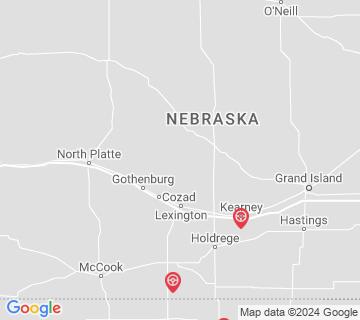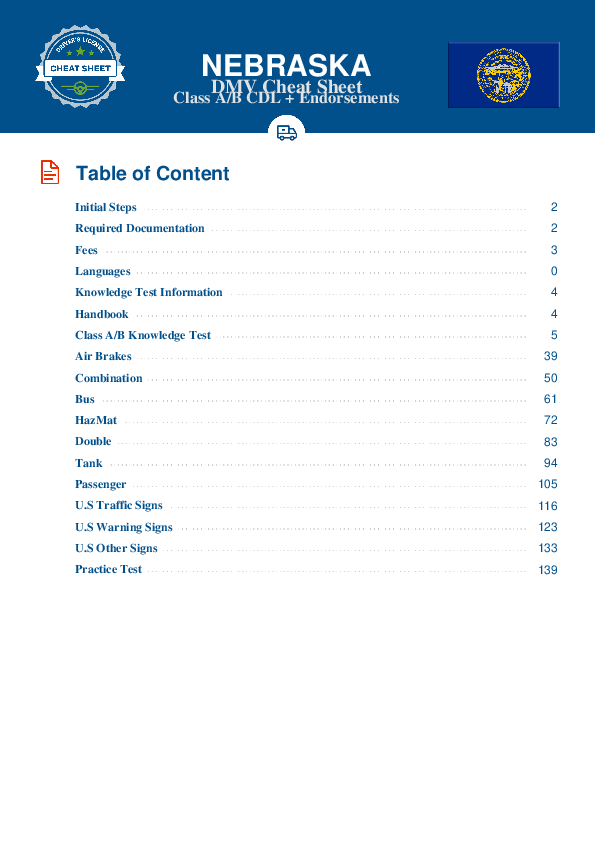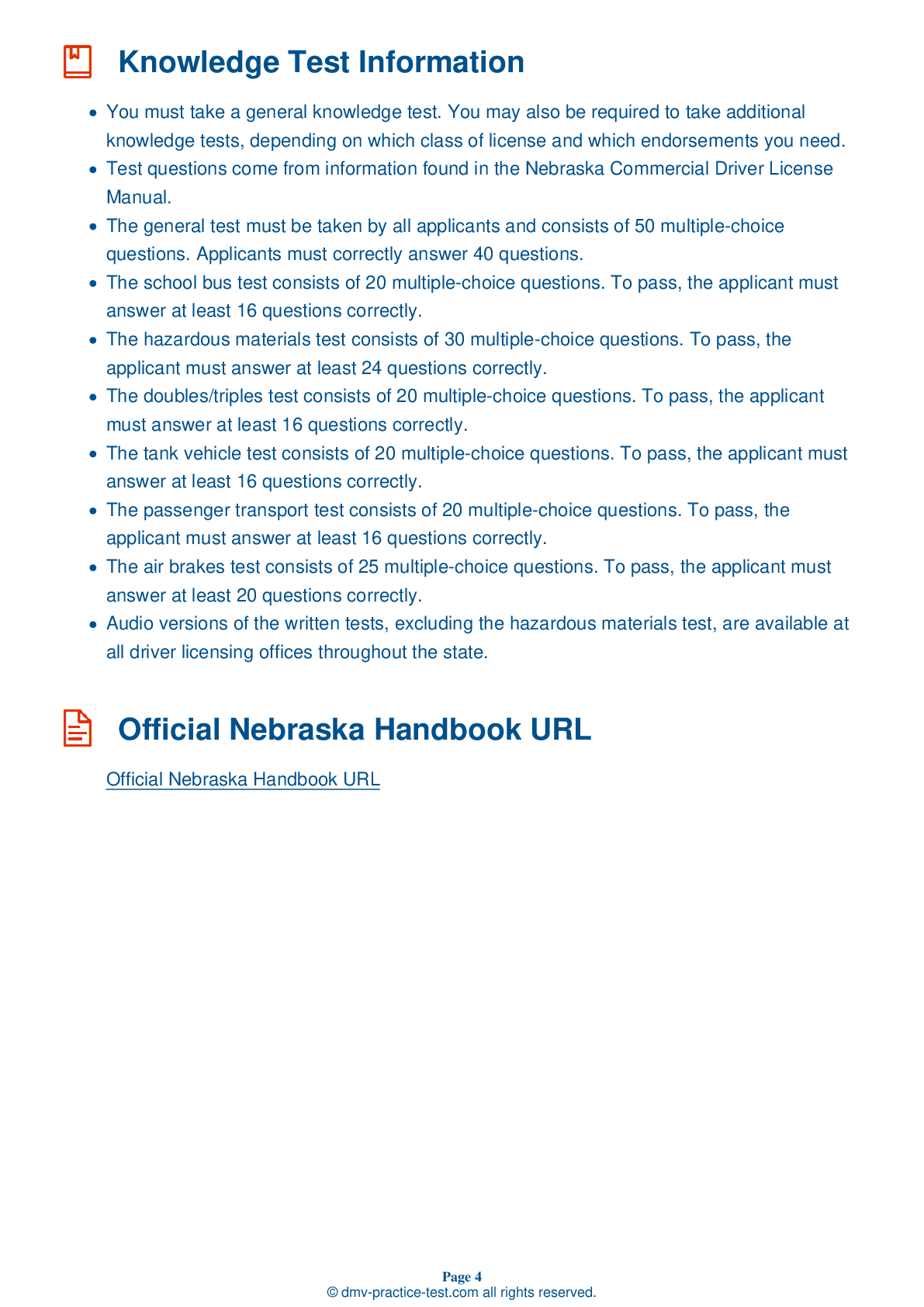Knowledge Test Class B #2
Class B Driving Test | Nebraska 2025 #2 Page 6 of 7
Train for FREE online with our Nebraska class B license test. The official exam test consists of several obligatory parts, with all of them checking your knowledge of different blocks of road rules. If you need to obtain a NE CDL class B permit in 2025, practice as much as possible. Free sample tests published on our website will help you check and improve your knowledge and boost your grades. Please bear in mind that CDL class B requirements may vary from state to state.
50
40
20
36 . A vehicle equipped with an Anti-Lock Braking System (ABS) can be identified by:
A metal plate on the inside of the driver’s side door.
You can tell that your vehicle is equipped with an Anti-Lock Braking System (ABS) if it has a yellow ABS malfunction lamp on the instrument panel.
37 . When using a fire extinguisher on a fire, you should:
Aim the fire extinguisher at the ground about two feet away from the fire.
When using a fire extinguisher, you should stay as far away from the flames as possible and aim at the base of the fire.
38 . If being tailgated, you should open up your following distance.
If someone is tailgating you, it is a good idea to open up the space ahead of your vehicle to make it easier for the driver to pass you. Increasing your speed is not a good idea because the driver may continue to tailgate you at the higher speed, only increasing the danger.
39 . Drivers trapped behind a slow-moving vehicle often:
It is common for drivers to tailgate slow-moving vehicles that cannot keep up with the speed of surrounding traffic. If you are being tailgated, allow the other driver to pass your vehicle.
40 . Don't spend too much time looking at a single mirror because:
The mirror may not provide an accurate view of the road.
Check you mirrors frequently while driving, but check them quickly. Staring at one mirror for too long can cause you to drive a long distance without knowing what is ahead.
41 . What is a concern immediately after it begins raining?
People will be using their windshield wipers needlessly.
Under wet conditions, roads are often most slippery when it first begins to rain. This is because the water mixes with oil and grease on the road that has not yet begun to wash away.
42 . Once cargo is secured onto a vehicle:
The securement of cargo must be checked before beginning a trip, within the first 50 miles of a trip, and then again every three hours or 150 miles thereafter.
Search the best driving school in your neighbourhood
2025 Nebraska | Frequently Asked Questions
To secure a CDL Bus endorsement in Nebraska, you must first possess a valid Commercial Driver's License (CDL). Then, pass the Passenger Transport Test, which covers the special driving skills and knowledge needed for safe passenger transport. Finally, pass a pre-trip inspection test and a skills test in a vehicle of the same type you will be driving.
To obtain a CDL Bus license in Nebraska, you must have a valid Nebraska driver's license. You'll need to pass the CDL general knowledge test, the passenger transport test, and a driving skills test in a bus-like vehicle. Also required are a medical examination and a background check. You must be at least 21 years old for interstate driving.
While Nebraska doesn't mandate specific training for a CDL Bus endorsement, it's beneficial to undergo professional training. It prepares you for the written and skills tests. You must have a valid Nebraska CDL, pass the passenger transport test, and demonstrate driving skills in a similar vehicle. A medical examination and background check are also required.
CDL Bus licenses are classified into three main categories: Class A, Class B, and Class C. Class A is for vehicles with a combined weight of 26,001 pounds or more. Class B is for vehicles designed to transport 16 or more passengers, including the driver. Class C is for smaller vehicles that do not fit into the first two classes but transport 16 or more passengers.
No, you cannot use your personal vehicle for the CDL Bus driving test. The vehicle used must match the class and type of vehicle you will be driving with your CDL. For instance, if you're testing for a passenger bus endorsement, you must use a passenger bus for your test.
The CDL Bus driving test in Nebraska assesses various skills including pre-trip vehicle inspection, basic vehicle control, and on-road driving. You'll be tested on maneuvers like turning, merging, and backing up. The examiner also checks your ability to obey traffic laws, use mirrors, handle intersections, respond to changing traffic conditions, and manage passenger safety.
Yes, additional medical and physical prerequisites are necessary for a CDL Bus endorsement. Drivers must pass a Department of Transportation (DOT) physical examination every two years. This exam evaluates vision, hearing, blood pressure, and medical conditions that could affect driving ability, such as epilepsy or heart disease.
No, it is not permissible to transport passengers without a valid CDL Bus endorsement in Nebraska. The law requires anyone driving a vehicle designed to carry 16 or more passengers (including the driver) to hold a valid CDL with a Passenger (P) endorsement. Driving without the appropriate license or endorsement can result in legal penalties.
Yes, a CDL Bus endorsement can be added to your existing commercial driver's license in Nebraska. It requires passing the Passenger Endorsement Knowledge Test and a skills test in the type of vehicle you'll be driving. You don't need to apply for a new CDL, but there might be additional fees for the endorsement.
Yes, there are several restrictions for drivers with a CDL Bus endorsement in Nebraska. Drivers must not have any serious traffic violations within the last two years. Additionally, they must pass a Department of Transportation physical examination every two years, and maintain a clean driving record. Any failure to comply with these restrictions can lead to the loss of their endorsement.




